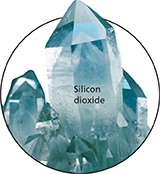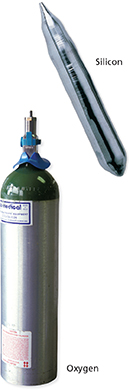Figure 3 Elements have different properties than their compounds. Silicon is a gray solid and oxygen is a colorless gas, which can be stored in a metal tank. Silicon and oxygen combine to form silicon dioxide—a colorless, transparent solid found in most grains of sand.


Symbols for Elements
In 1813, Jöns Berzelius, a Swedish chemist, suggested that chemists use symbols to represent elements. Many of the symbols he assigned to elements are still used. Each symbol has either one or two letters. The first letter is always capitalized. If there is a second letter, it is not capitalized.
It is easy to see why C and Al are used to represent carbon and aluminum. But why does gold have the symbol Au? The symbols that Berzelius chose were based on the Latin names of the elements. The Latin name for gold is aurum.
The symbols allow scientists who speak different languages to communicate without confusion. For example, nitrogen is known as azote in France, as stickstoff in Germany, and as nitrógeno in Mexico. But scientists who speak English, French, German, and Spanish all agree that the symbol for the element nitrogen is N.
Sometimes an element's name contains a clue to its properties. For example, the name hydrogen comes from the Greek words hydro and genes, meaning “water” and “forming.”
Compounds
Water is composed of the elements hydrogen and oxygen. When electricity passes through water, bubbles of oxygen and hydrogen gas form and rise to the surface of the water. If the gases are collected in a container and a flame is brought near the mixture, the hydrogen and oxygen react and form water. Water is classified as a compound. A compound is a substance that is made from two or more simpler substances and can be broken down into those simpler substances. The simpler substances are either elements or other compounds.
The properties of a compound differ from those of the substances from which it is made. For example, oxygen and hydrogen are gases at room temperature, but water is a liquid. Hydrogen can fuel a fire, and oxygen can keep a fire burning, but water does not burn or help other substances to burn. In fact, water is one of the substances commonly used to put out fires.
Figure 3 shows another example of how properties change when elements join and form compounds. Silicon dioxide is a compound found in most light-colored grains of sand. It is a colorless, transparent solid. Yet, silicon dioxide is made from a colorless gas (oxygen) and a gray solid (silicon). Silicon is used to make chips for computers.
 A compound always contains two or more elements joined in a fixed proportion. For example, in silicon dioxide, there are always two oxygen atoms for each silicon atom. (Di- means “two.”) In water, there are always two hydrogen atoms for each oxygen atom.
A compound always contains two or more elements joined in a fixed proportion. For example, in silicon dioxide, there are always two oxygen atoms for each silicon atom. (Di- means “two.”) In water, there are always two hydrogen atoms for each oxygen atom.





